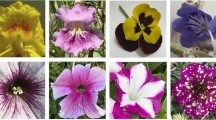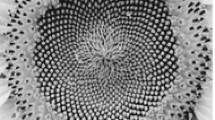Abstract
Based on a careful examination of the onset of violet colored dots along the filaments in the develo** floral bud stage and the formation of alternating bands of violet and white color in the matured flowers of Passiflora incarnata (Passion flower), it is concluded that the pattern arises from a competition between the production of violet colored anthocyanin and the colorless flavonols along the filaments. The activator-inhibitor model of Gierer and Meinhardt along with the reaction diffusion theory of Turing is used to explain the formation of concentric rings in the flower.
Graphic abstract










Similar content being viewed by others
References
Ball P 2016 Patterns in nature: why the natural world looks like the way it does (Chicago: University of Chicago Press)
Bhati AP 2014 Understanding the mechanism of pattern formation in passion flower, MSc thesis, Indian Institute of Science Education and Research Mohali, Mohali
Bhatnagar SS and Sehgal JL 1926 Die konzentrisch gefärbten ringe der runkelrübe und das Liesegang-phänomen. Kolloid Zeit. 39 264–268
Chailakhyan MK 1936 New facts in support of the hormonal theory of plant development. Dokl. Akad. Nauk SSSR 4 77–81
Culbertson CT, Jacobson SC and Ramsey JM 2002 Diffusion coefficient measurements in microfluidic devices. Talanta 56 365–373
Field RJ and Noyes RM 1977 Oscillations in chemical systems. 18. mechanisms of chemical oscillators: Conceptual bases. Acc. Chem. Res. 10 214–221
Gierer A and Meinhardt H 1972 A theory of biological pattern formation. Kybernetik 12 30–39.
Goyal S, Reji R, Tripathi SS and Sathyamurthy N 2019 Synchronous pulsed flowering in passion flower (Passiflora incarnata). Curr. Sci. 117 1211–1216
Hearn DJ 2019 Turing-like mechanism in a stochastic reaction-diffusion model recreates three dimensional vascular patterning of plant stems. PLoS One 14 e0219055
Kondo S and Asai R 1995 A reaction-diffusion wave on the skin of the marine angelfish Pomacanthus. Nature 376 765–768
Kondo S and Miura T 2010 Reaction-diffusion model as a framework for understanding biological pattern formation. Science 329 1616–1620
Krug, H-J and Brandtstädter H 1999 Morphological characteristics of Liesegang rings and their simulations. J. Phys. Chem. A 103 7811–7820
Lang A and Melchers G 1943 Die photoperiodische reaktion von Hyoscyamus niger. Planta 33 653–702
Lotka AJ 1910 Contributions to the theory of periodic reactions. J. Phys. Chem. 14 271–274
McGuigan H and Brough GA 1923 Rhythmic banding of precipitates (Liesegang’s rings). J. Bio. Chem. 58 415–423.
Meinhardt H 1982 Models of biological pattern formation (New York: Academic Press)
Meinhardt H 1995 Dynamics of stripe formation. Nature 376 722–723
Meinhardt H 2009 The algorithmic beauty of sea shells 4th ed. (Berlin: Springer-Verlag)
Murray JD 2003 Mathematical biology 3rd ed., volume II (Berlin: Springer)
Painter K, Maini P and Othmer HG 1999 Stripe formation in juvenile Pomacanthus explained by a generalized Turing mechanism with chemotaxis. Proc. Nat. Acad. Sci. (USA) 96 5549–5554
Ramasastry SS, Silori Y, Chawla S, De AK and Sathyamurthy N 2021 unpublished
Rashevsky N 1961 Mathematical principles in biology and their applications (Chicago: Thomas)
Singh AP and Nüsslein-Volhard C 2015 Zebrafish stripes as a model for vertebrate colour pattern formation. Curr. Biol. 25 R81–R92
Stern KH 1954 The Liesegang phenomenon. Chem. Rev. 54 79–99
Thomas D and Kernezev JP 1975 Analysis and control of immobilized enzyme systems (Berlin: Springer-Verlag)
Turing AM 1952 The chemical basis of morphogenesis. Phil. Trans. R. Soc. B 237 37–72
van Roekel HWH, Rosier BJHM, Meijer LHH, Hilbers PAJ, Markvoort AJ, Huck WTS and de Greef TFA 2015 Programmable chemical reaction networks: emulating regulatory functions in living cells using a bottom-up approach. Chem. Soc. Rev. 44 7465–7483
Williams RB and Murdoch MB 1966 Phytoplankton production and chlorophyll concentration in the beaufort channel, north carolina. Technical report, Bureau of Commercial Fisheries, Radiobiological Laboratory, Beaufort, North Carolina.
Winfree AT 1972 Spiral waves of chemical activity. Science 175 634–636
Winter RB, Berg OG and Hippe PHv 1981 Diffusion-driven mechanisms of protein translocation on nucleic acids. 3. The Escherichia coli lac repressor-operator interaction: Kinetic measurements and conclusions. Biochemistry 20 6961–6977
Yuan Y-W, Rebocho AB, Sagawa JM, Stanley LE and Bradshaw HD 2016 Competition between anthocyanin and flavonol biosynthesis produces spatial pattern variation of floral pigments between mimulus species. Proc. Nat. Acad. Sci. (USA) 113 2448–2453
Acknowledgements
The authors are grateful to Dr. Amitabh Nandi and Dr. Vinod Gaur for their suggestions in the initial stages of the work and Dr. T. Ramasami for helpful discussions while preparing the manuscript. NS is grateful to the Department of Science and Technology, New Delhi, for a J C Bose National Fellowship (2006-2016).
Author information
Authors and Affiliations
Corresponding author
Additional information
Communicated by BJ Rao.
Corresponding editor: B J Rao
Rights and permissions
About this article
Cite this article
Bhati, A.P., Goyal, S., Yadav, R. et al. Pattern formation in Passiflora incarnata: An activator-inhibitor model. J Biosci 46, 84 (2021). https://doi.org/10.1007/s12038-021-00202-1
Received:
Accepted:
Published:
DOI: https://doi.org/10.1007/s12038-021-00202-1




